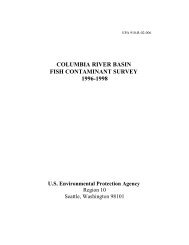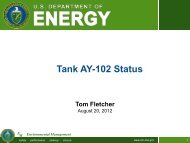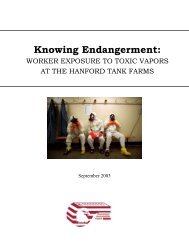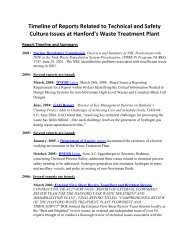Reducing the Risks of High-Level Radioactive Wastes at Hanford
Reducing the Risks of High-Level Radioactive Wastes at Hanford
Reducing the Risks of High-Level Radioactive Wastes at Hanford
You also want an ePaper? Increase the reach of your titles
YUMPU automatically turns print PDFs into web optimized ePapers that Google loves.
48 Alvarez<br />
HANFORD HISTORY<br />
In January 1943, just weeks after <strong>the</strong> world’s first self-sustaining nuclear chain<br />
reaction took place <strong>at</strong> <strong>the</strong> University <strong>of</strong> Chicago, <strong>the</strong> <strong>Hanford</strong> site in <strong>the</strong> steppe<br />
shrub desert <strong>of</strong> Sou<strong>the</strong>astern Washington was selected to make plutonium<br />
for <strong>the</strong> first <strong>at</strong>omic weapons. Its rel<strong>at</strong>ive isol<strong>at</strong>ion and close proximity to <strong>the</strong><br />
large w<strong>at</strong>er and electrical supplies from <strong>the</strong> Columbia River made <strong>the</strong> 560-<br />
square-mile site a seemingly ideal loc<strong>at</strong>ion. Over <strong>the</strong> next 44 years, until U.S.<br />
Energy Secretary John Herrington announced th<strong>at</strong> <strong>the</strong> n<strong>at</strong>ion was “awash in<br />
plutonium,” 1 <strong>Hanford</strong>’s nine reactors had produced 67.4 metric tons <strong>of</strong> this<br />
fissile m<strong>at</strong>erial. 2<br />
As Cold War memories fade, <strong>the</strong> sobering afterm<strong>at</strong>h <strong>of</strong> <strong>the</strong> nuclear arms<br />
race is no more apparent than <strong>at</strong> <strong>Hanford</strong>, where <strong>the</strong> n<strong>at</strong>ion’s most hazardous<br />
byproducts <strong>of</strong> nuclear weapons production are stored. With nearly 60 percent<br />
<strong>of</strong> <strong>the</strong> n<strong>at</strong>ion’s defense high-level radioactive waste, 3 <strong>Hanford</strong>’s legacy is in a<br />
league unto itself in terms <strong>of</strong> magnitude and risk.<br />
The United St<strong>at</strong>es started to come to terms with this problem when <strong>the</strong><br />
Congress established a process to dispose <strong>of</strong> geologically defense and civilian<br />
high-level radioactive waste in <strong>the</strong> 1982 Nuclear Waste Policy Act. The following<br />
year, borosilic<strong>at</strong>e glass was selected by <strong>the</strong> U.S. Department <strong>of</strong> Energy (DOE)<br />
as <strong>the</strong> preferred disposal form for defense high-level wastes. Vitrified wastes<br />
from <strong>Hanford</strong>, and four o<strong>the</strong>r sites, 4 would <strong>the</strong>n be disposed along with DOE<br />
and commercial spent power reactor fuel in <strong>the</strong> same repository.<br />
After more than 20 years <strong>of</strong> fits, starts, and soaring costs, less than five percent<br />
<strong>of</strong> <strong>the</strong> n<strong>at</strong>ion’s defense high-level wastes have been processed. 5 At <strong>Hanford</strong>,<br />
DOE is still in <strong>the</strong> stages <strong>of</strong> design and construction. The success <strong>of</strong> this unprecedented<br />
endeavor, estim<strong>at</strong>ed to cost between $41.6 and $56.9 billion, 6 depends<br />
largely on <strong>the</strong> resolution <strong>of</strong> three key questions.<br />
1. Can <strong>the</strong> processing <strong>of</strong> <strong>Hanford</strong>’s high-level wastes be done safely?<br />
2. Can DOE “fast track” a full-scale, first-<strong>of</strong>-a-kind oper<strong>at</strong>ion, without significant<br />
technological failures?<br />
3. Will <strong>the</strong> shallow on-site disposal <strong>of</strong> radioactive wastes from <strong>Hanford</strong>’s tanks<br />
ensure adequ<strong>at</strong>e protection <strong>of</strong> health and n<strong>at</strong>ural resources from <strong>the</strong> present<br />
to thousands <strong>of</strong> years from now?<br />
HANFORD’S HIGH-LEVEL WASTES<br />
<strong>High</strong>-level wastes were gener<strong>at</strong>ed by dissolution <strong>of</strong> 119,271 MTU (metric tons<br />
uranium) <strong>of</strong> spent reactor fuel 7 and <strong>the</strong> subsequent solvent extraction <strong>of</strong> plutonium<br />
and o<strong>the</strong>r m<strong>at</strong>erials. 8 Because <strong>of</strong> <strong>the</strong>ir highly intense radioactivity <strong>the</strong>y<br />
must be handled remotely in heavily shielded structures. Until recently, <strong>the</strong>ir







